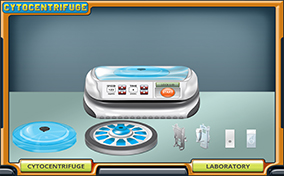What is a cytocentrifuge?
A cytocentrifuge is a special type of centrifuge designed to separate cells from fluids and deposit them as a single layer in a defined circle on a slide.
What is the most common type of cytocentrifuge?
The most common cytocentrifuge is a Thermo Shandon Cytospin.
What components are part of the cytoclip assembly?
The major parts of a cytocentrifuge include the following: a) a disposable cytospin chamber, b) a funnel with filter card, c) the stainless steel cytoclip, and d) the microscope slide.
What is the advantage of using a cytocentrifuge to prepare body fluid slides in hematology or microbiology?
A number of advantages arise in the preparation of body fluids through the use of a cytocentrifuge. These include: a) consistently providing good cell recovery with little cell distortion, b) improving the recovery of bacteria from samples when clinical findings suggest infection, and c) generally reducing risk to laboratory personnel by keeping the potentially hazardous specimens contained.
What volume of fluid must be used in the cytospin chamber (funnel)?
The volume of fluid used in the cytospin chamber is dependent on the appearance of the fluid. If the fluid is clear, use 5 drops from a plastic transfer pipet or approximately 0.25 mL. If the fluid is cloudy, use 1-3 drops from a plastic transfer pipet. The cloudier the fluid, the fewer drops are needed. If the fluid is bloody, make an appropriate saline dilution based on the cell count and use 5 drops from a plastic transfer pipet. In general, always use between 0.1-0.5 mL of fluid sample with 0.5 mL being the maximum used.
What departments of the laboratory can utilize the cytocentrifuge?
Many laboratory units use cytocentrifuges including cytology, hematology, and microbiology.
What solution is best to add to the hematological sample to increase adhesion of the cells to the slide when the sample does not contain much protein?
If the sample contains small amounts of protein, 1-2 drops of 22% or 30% bovine albumin added to the fluid sample will increase the adhesion of the cells to the slide.
Are thick joint fluids handled differently than other fluids?
Yes, if joint fluids are too thick, they may not completely absorb in the filter paper upon centrifugation. A thick fluid consistency can be reduced by adding a small amount of the enzyme hyaluronidase prior to centrifugation.
How fast and how long should body fluids be spun in the cytocentrifuge?
On average, hematology specimens are usually spun in the cytocentrifuge at 500-700 rpm for 5 minutes. If there are known large cells or fragile cells present in fluid, then spin the cytocentrifuge at 600 rpm for 7-10 minutes. Microbiology specimens require higher cytocentrifuge spin speeds of 2,000 rpm for 5-10 minutes to recover any bacteria that may be present.
How is the cytospin chamber (funnel) loaded?
Loading the cytospin chamber requires a number of steps. First, assemble the cytoclip, slide, and cytospin sample chamber with the filter card and insert this assemblage into the sealed head assembly that has been removed from the base of the centrifuge. Next, add 1-2 drops of albumin, if needed, into the bottom of the chamber, and then add the sample. Then, place the plastic cap on the sample chamber. Finally, place the lid on the sealed head assembly and transfer the entire assembly into the base of the centrifuge. Do not snap the cytospin sealed head lid down onto the bowl while the assembly is sitting on the drive shaft since this may lead to damage of the shaft and motor.
Why are cytospin chambers (funnels) tilted in the centrifuge?
The funnels of the cytospin chamber are angled in the centrifuge so the specimen avoids contacting the slide or the filter card before the cytocentrifuge begins the spinning process.
What is the purpose of the filter card?
The purpose of the filter card is to absorb excess fluid as the sample holders are rotated in the sealed head.
Is it necessary to air dry hematology-prepared smears after cytocentrifugation?
Yes, air drying of hematology-prepared smears is required after cytocentrifugation in order to prevent washing the cells off the slide during the staining process.
What happens to the used cytoclip assemblies?
At the conclusion of the cytocentrifugation process, place the disposable cytofunnels into a biohazard waste container. Place the reusable cytoclips in a 10% bleach solution for 15 minutes. Finally, rinse the cytoclips in clear water and dry the clips using hot air.
How should the slides appear after cytocentrifugation?
Post-cytocentrifugation, the samples on the slides should appear as a single layer of cells with minimal overlap. The morphology of the cells should be clearly discernible on the slide.
 Have you had an opportunity to use a cytocentrifuge? Do you know when to use a cytocentrifuge? So, what will you do in this simulation? You will prepare a couple of hematological smears using a cytocentrifuge.
Have you had an opportunity to use a cytocentrifuge? Do you know when to use a cytocentrifuge? So, what will you do in this simulation? You will prepare a couple of hematological smears using a cytocentrifuge.


